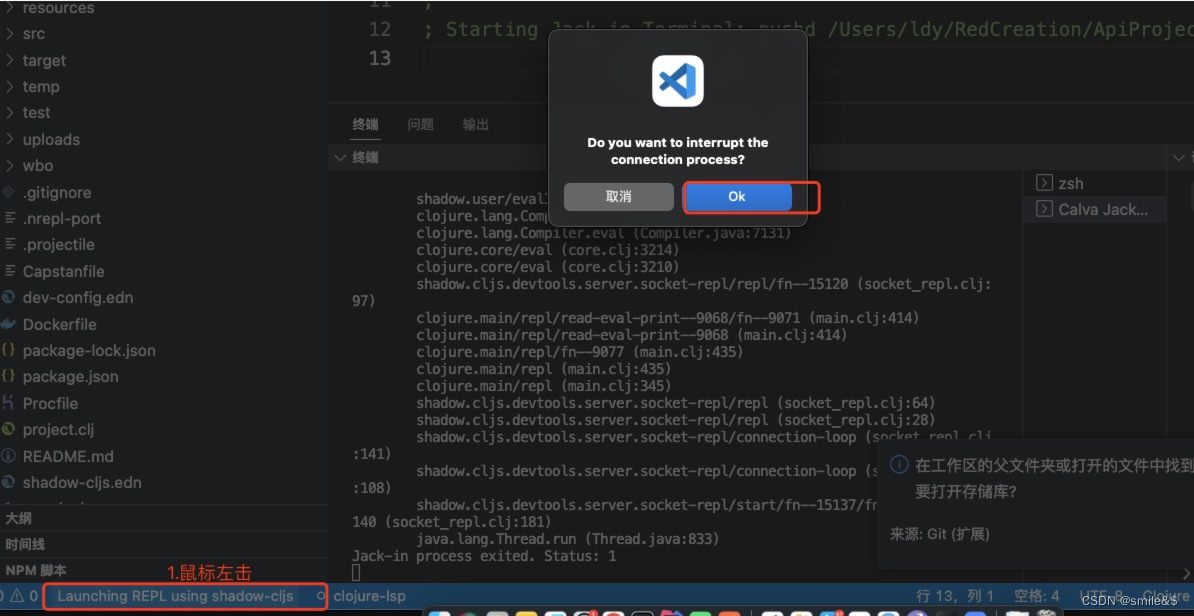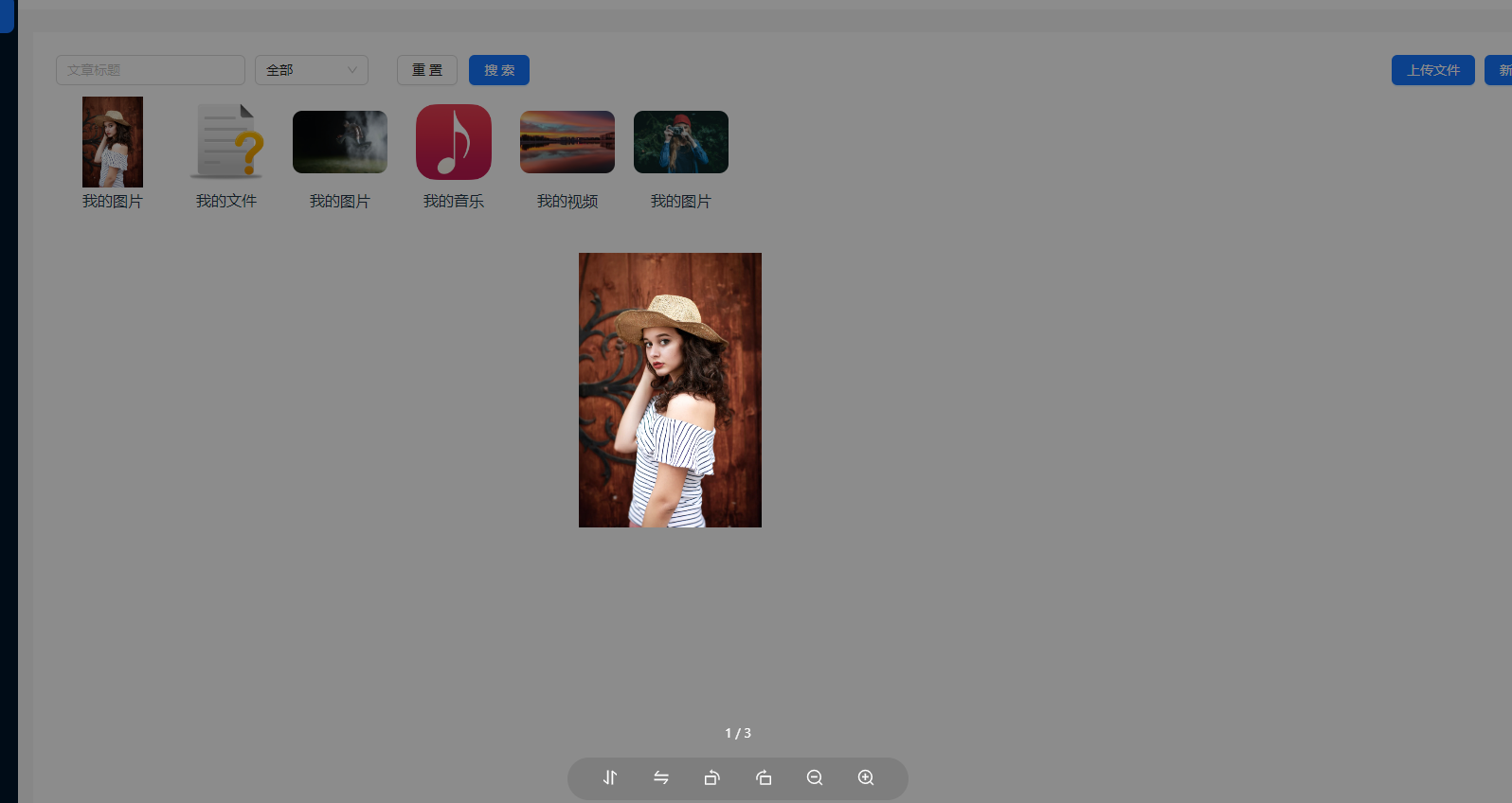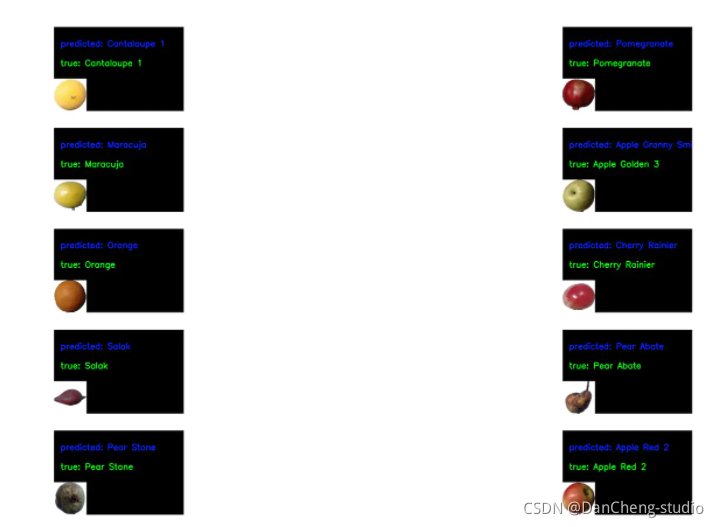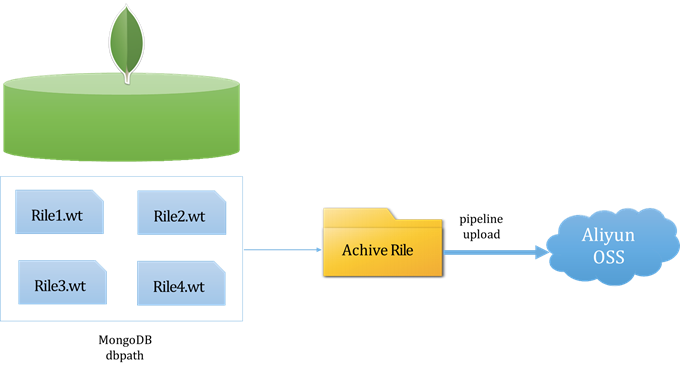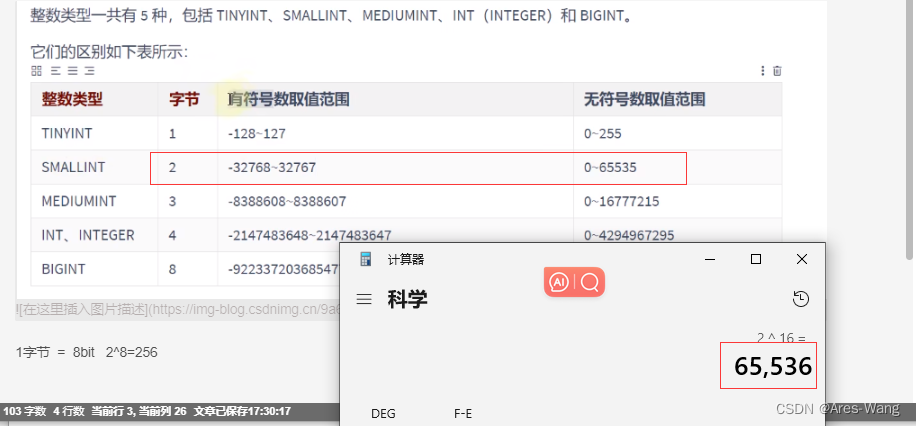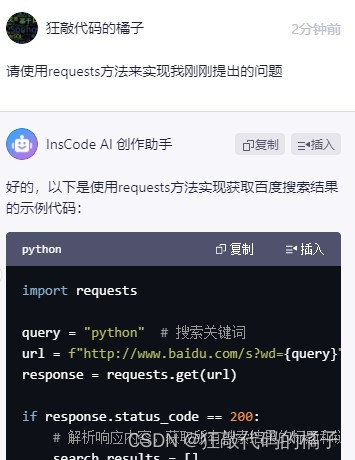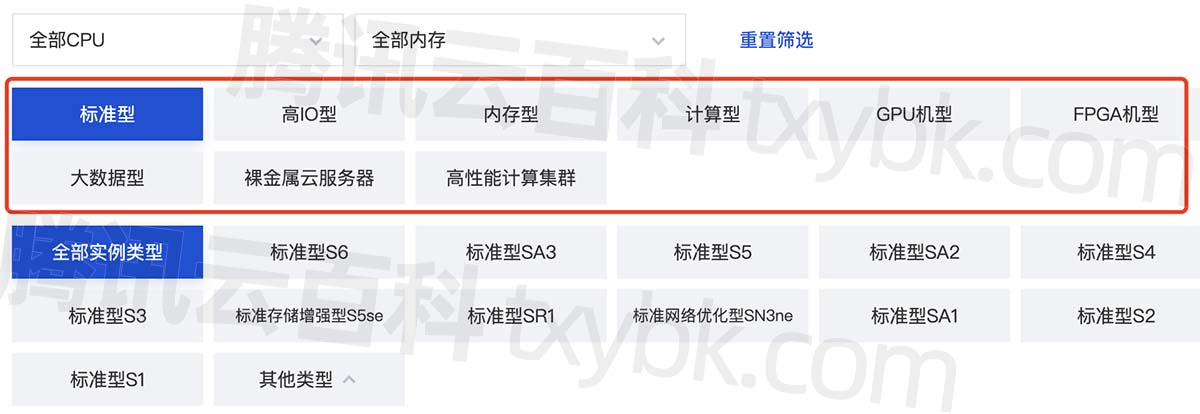前言
提到爬虫可能大多都会想到python,其实爬虫的实现并不限制任何语言。
下面我们就使用js来实现,后端为express,前端为vue3。
实现功能
话不多说,先看结果:
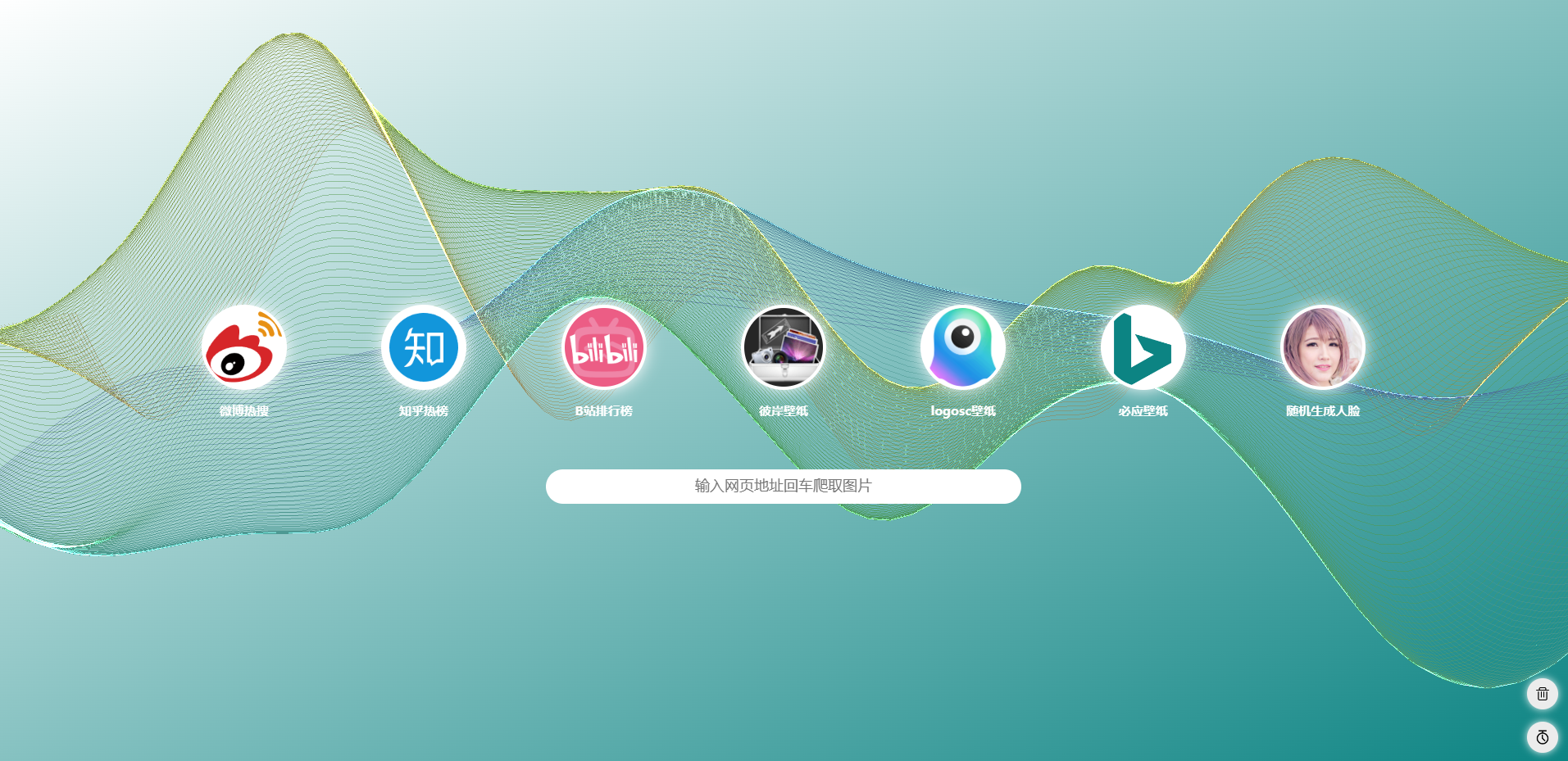
这是项目链接:https://gitee.com/xi1213/worm
项目用到的库有:vue、axios、cheerio、cron、express、node-dev
计划功能有:
- 微博热榜爬取。
- 知乎热榜爬取。
- B站排行榜爬取。
- 三个壁纸网站爬取。
- 随机生成人脸。
- 爬取指定页面所有图片。
- 删除爬取的数据。
- 定时任务(开发中)。
使用形式为:
双击打包出的exe(最好右键管理员运行,以防权限不足)。

双击exe后会弹出node后端启动的黑框。
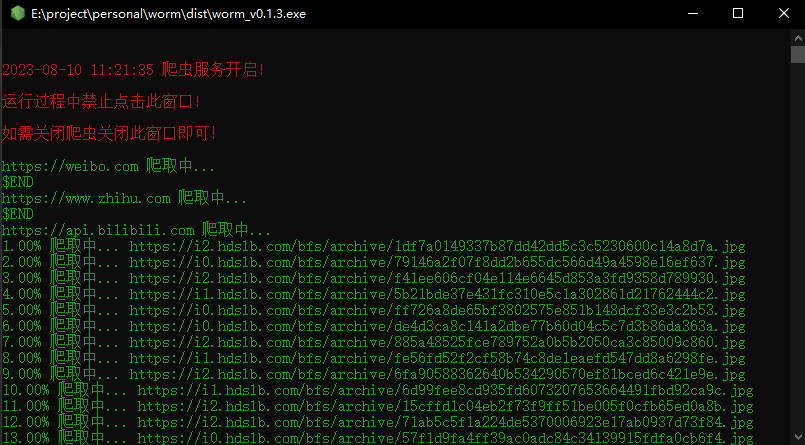
自动在浏览器中打开操作界面(用户界面)。

爬取出的数据在exe同级目录下的exportData中。
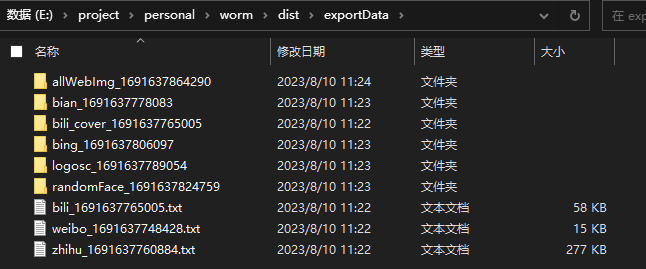
具体实现
微博热榜
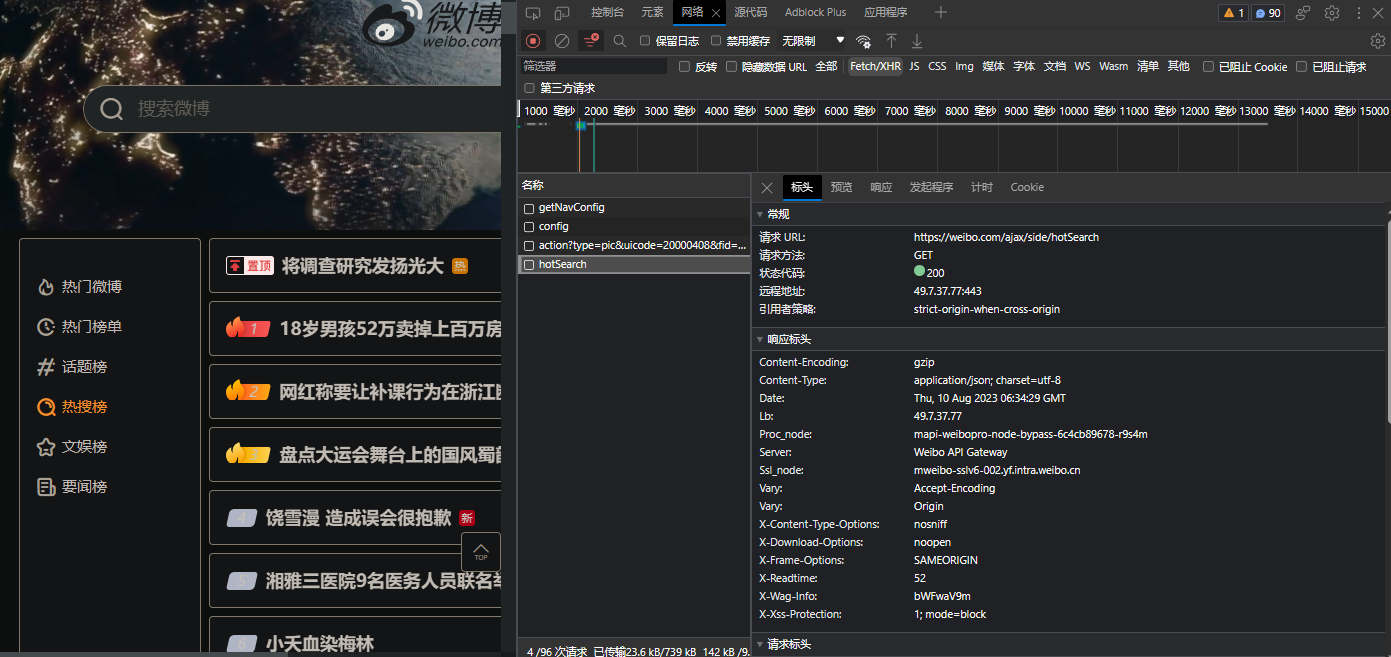
打开微博官网,f12分析后台请求,会发现它的热榜数据列表在请求接口:https://weibo.com/ajax/side/hotSearch 中,无参。
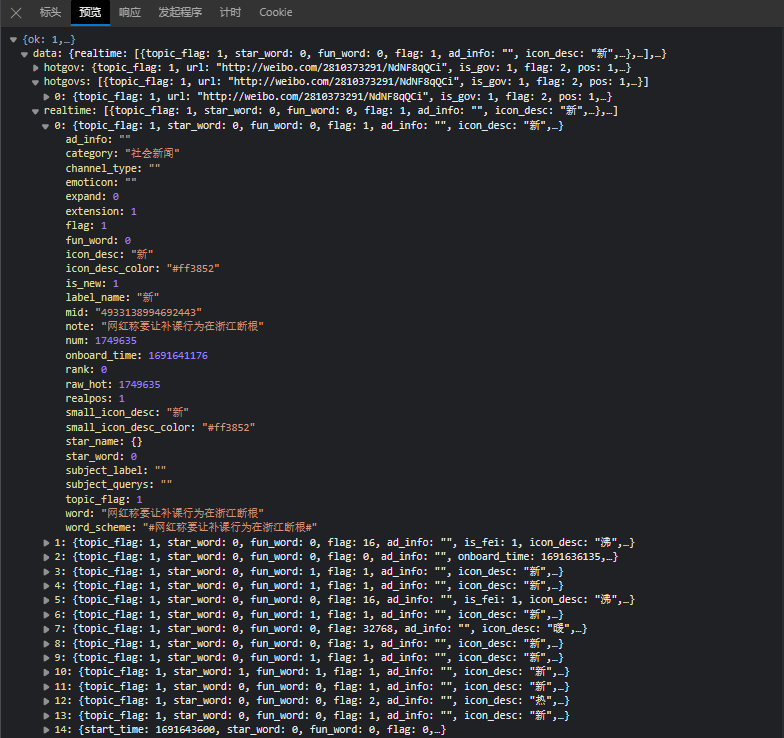
在接口列表realtime中根据页面信息,推测其字段含义:
- word为关键字,
- category为类别,
- https://s.weibo.com/weibo?q=%23 + word为链接,
- num为热度。
既然数据是现成的,那我们直接使用axios即可。
获取到数据列表后将其遍历拼接成指定格式的字符串,写入txt,下面是具体方法:
weibo.js
let axios = require('axios'),writeTxt = require("../utils/writeTxt"),{ addMsg } = require("../store/index");//抓取weibo
async function weiboWorm(dir, time) {let com = 'https://weibo.com';addMsg(`${com} 爬取中...`)let res = await axios.get(`${com}/ajax/side/hotSearch`);//拼接数据let strData = `微博热榜\r\n爬取时间:${time}\r\n`await res.data.data.realtime.forEach((l, index) => {strData = strData +'\r\n序号:' + (index + 1) + '\r\n' +'关键字:' + l.word + '\r\n' +'类别:' + l.category + '\r\n' +'链接:https://s.weibo.com/weibo?q=%23' + l.word.replace(/\s+/g, "") + '\r\n' +'热度:' + l.num + '\r\n' +'\r\n\r\n=================================================================================================================='})writeTxt(`${dir}/weibo_${Date.now()}.txt`, strData);//写入txtaddMsg('$END');
}module.exports = weiboWorm;
writeTxt.js
let fs = require('fs');//写入txt
function writeTxt(filePath, data) {fs.writeFile(filePath, data, (err) => {})
}module.exports = writeTxt;
需要注意的是在windows中换行使用的是\r\n,在链接中需要去掉空格。
知乎热榜
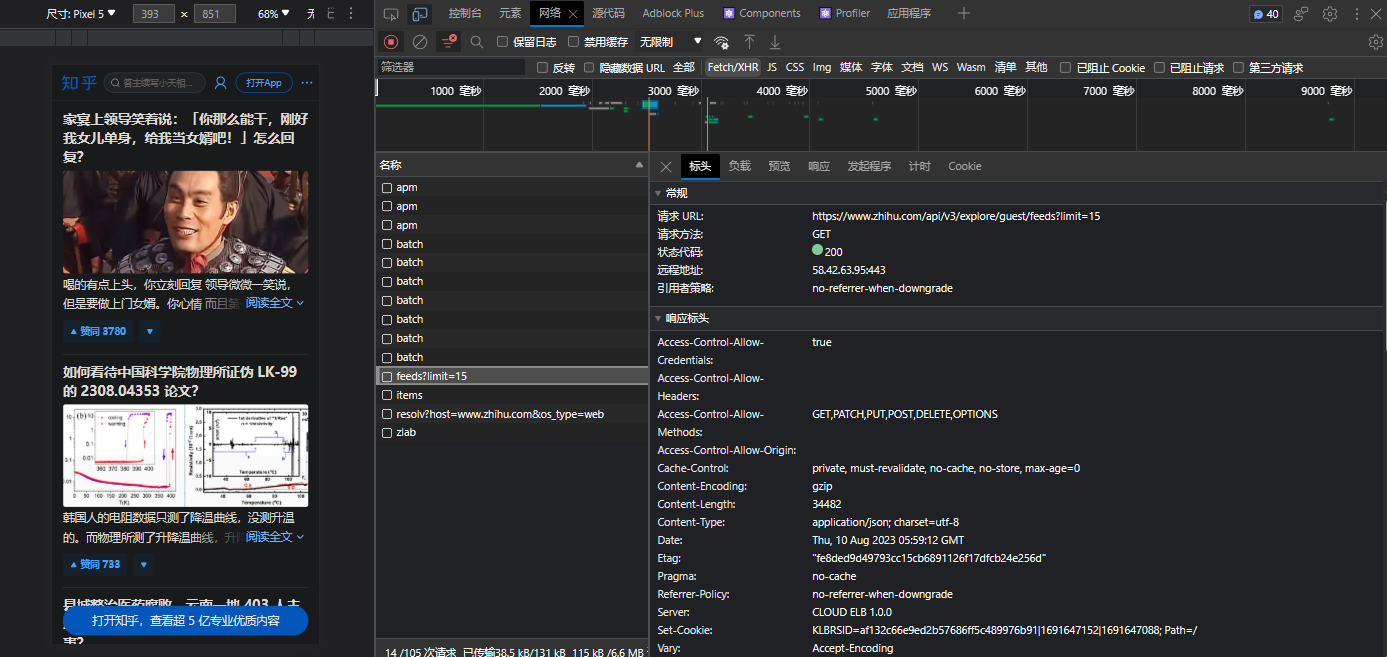
打开知乎官网,会发现它是需要登录的。
f12后点击左上角第二个按钮,在浏览器中切换为手机布局,刷新后即可不登录显示文章信息。
分析请求发现文章数据在请求接口:https://www.zhihu.com/api/v3/explore/guest/feeds 中,参数为limit,限制文章数。
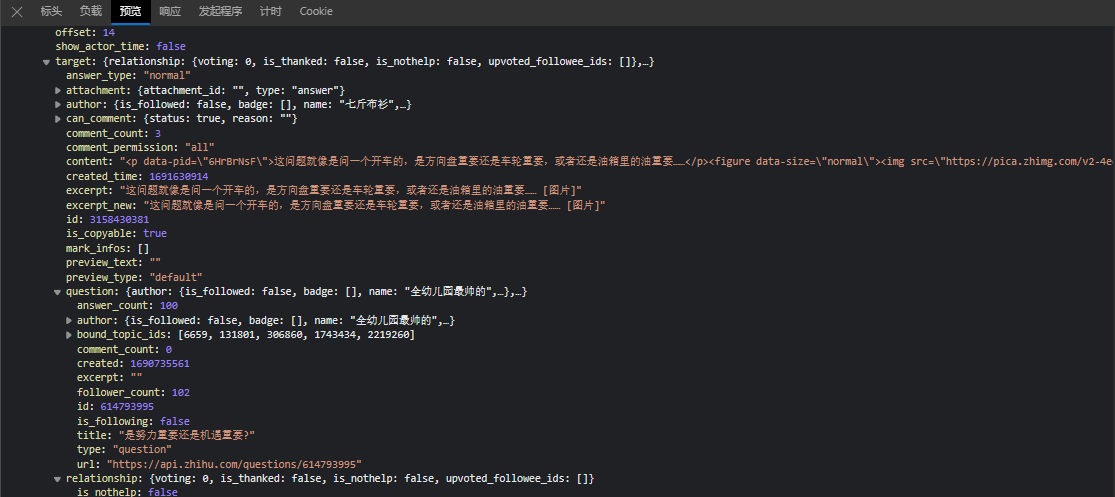
根据页面信息推测接口字段含义:
- target.question.title为问题标题,
- https://www.zhihu.com/question/ + target.question.id为问题链接,
- target.question.answer_count为问答数,
- target.question.author.name为提问的用户名,
- https://www.zhihu.com/org/ + target.question.author.url_token为提问的用户链接,
- target.content为高赞回答的内容。
需要注意的是高赞回答的内容中有html的标签,需要自己str.replace(/xxx/g,‘’)去除。
数据的具体获取方法同微博类似。
B站排行榜
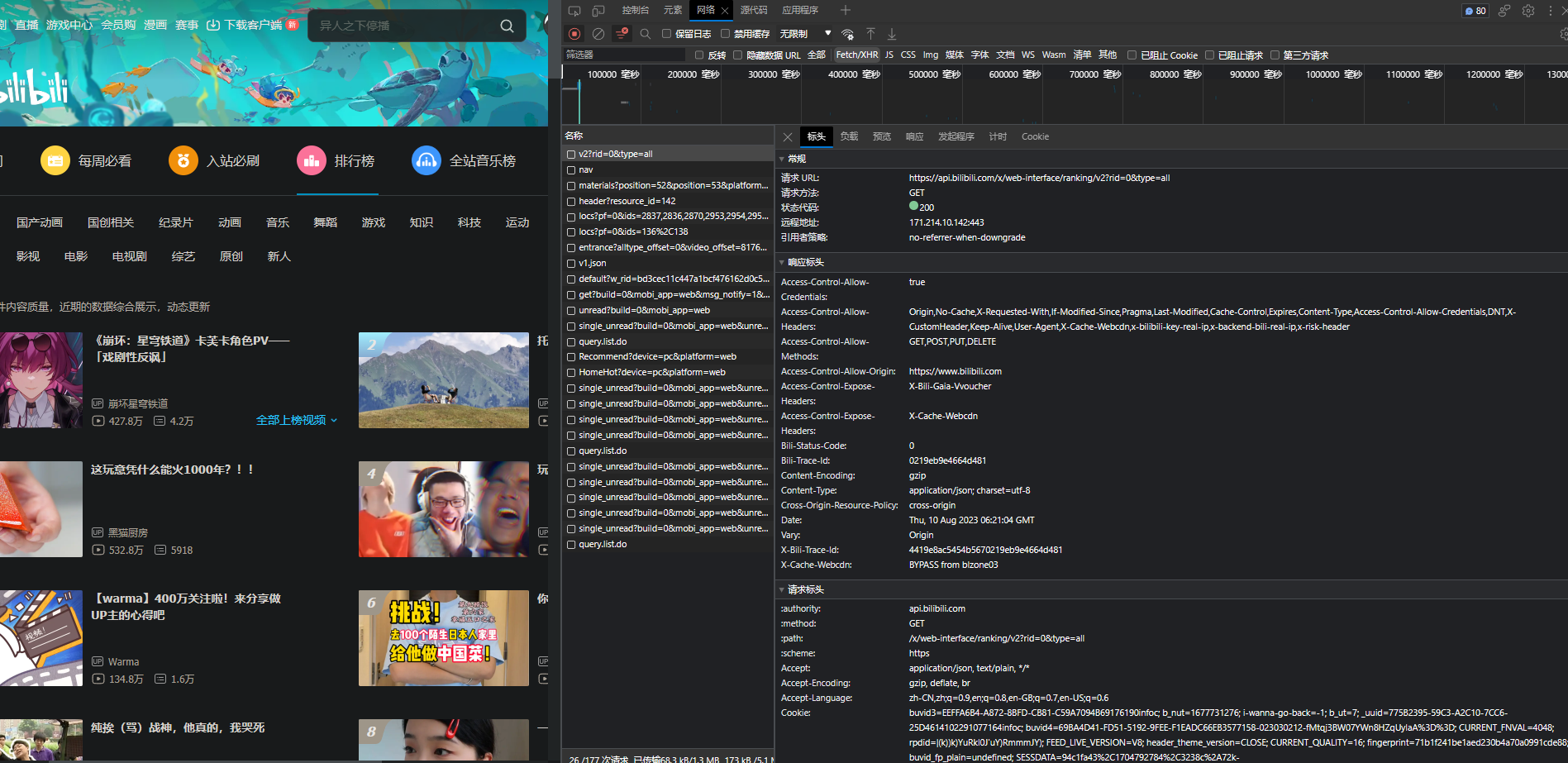
打开B站官网,找到排行榜,f12后发现数据在接口请求:https://api.bilibili.com/x/web-interface/ranking/v2 中,无参。
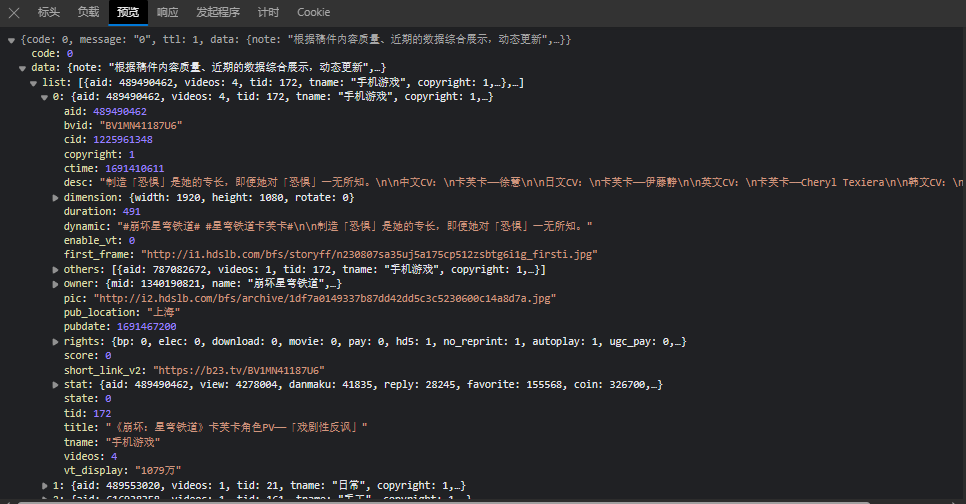
推测接口字段含义:
- title为视频标题,
- short_link_v2为视频短链,
- stat.view为视频浏览量,
- desc为视频描述,
- pic为视频封面,
- owner.name为视频作者,
- pub_location为发布地址,
- https://space.bilibili.com/ + owner.mid为作者链接。
数据的具体获取方法同微博类似。
壁纸网站爬取
项目使用了下面三个网站作为例子:
http://www.netbian.com/

https://www.logosc.cn/so/

https://bing.ioliu.cn/

具体思路如下:
- 用axios请求页面。
- 将请求到的数据使用cheerio.load解析(cheerio为node中的jq,语法同jq)。
- f12分析需要的数据在什么元素中,使用cheerio获取到该目标元素。
- 获取到元素中img的src内容。
- axios请求src(需要encodeURI转码,防止中文报错),记得设置responseType为stream。
- 有分页的需要考虑到动态改变url中的页码。
- 需要保证下载顺序,一张图片下载完成后才能下载另一张,否则下载量过大会有下载失败的可能,使用for配合async与await即可。
具体实现代码如下:
bian.js
let fs = require('fs'),cheerio = require('cheerio'),axios = require('axios'),downloadImg = require("../utils/downloadImg.js"),{ addMsg } = require("../store/index");//抓取彼岸图片
async function bianWorm(dir, pageNum) {let page = pageNum,//抓取页数pagUrlList = [],imgList = [],index = 0,com = 'https://pic.netbian.com';addMsg(`${com} 爬取中...`)for (let i = 1; i <= page; i++) {let url = i == 1 ? `${com}/index.html` : `${com}/index_${i}.html`;let res = await axios.get(url);let $ = cheerio.load(res.data);//解析页面let slistEl = $('.slist');//找到元素列表slistEl.find('a').each(async (j, e) => {pagUrlList.push(`${com}${$(e).attr('href')}`);//获取到页面url列表})}pagUrlList.forEach(async (p, i) => {let pRes = await axios.get(p);let p$ = cheerio.load(pRes.data);//解析页面let imgEl = p$('.photo-pic').find('img');//找到元素列表let imgUrl = `${com}${imgEl.attr('src')}`;//获取图片urlimgList.push(imgUrl);index++;//循环的次数等于列表长度时获取图片if (index == pagUrlList.length) {let dirStr = `${dir}/bian_${Date.now()}`;fs.mkdir(dirStr, (err) => { })downloadImg(imgList, dirStr);//下载图片}})
}module.exports = bianWorm;
downloadImg.js
let fs = require('fs'),axios = require('axios'),{ addMsg } = require("../store/index");//下载图片
async function downloadImg(list, path) {if (list.length == 0) {addMsg('$END');return;}// console.log(list.length);for (let i = 0; i < list.length; i++) {let url = encodeURI(list[i]);//转码,防止url中文报错try {//计算下载的百分比let percent = ((i + 1) / list.length * 100).toFixed(2);let msgStr = `${percent}% 爬取中... ${url}`;addMsg(msgStr);if (i == list.length - 1) {msgStr = `图片爬取完成,共${list.length}项。`addMsg(msgStr);addMsg('$END');}let typeList = ['jpg', 'png', 'jpeg', 'gif', 'webp', 'svg', 'psd', 'bmp', 'tif', 'tiff', 'ico'];let type = typeList.find((item) => {return url.includes(item);});//获取图片类型(type == undefined) && (type = 'jpg');//判断type是否为undefinedconst imgPath = `${path}/${i + 1}.${type}`;//拼接本地路径const writer = fs.createWriteStream(imgPath);const response = await axios.get(url, { responseType: 'stream', timeout: 5000 }).catch(err => { });response.data.pipe(writer);await new Promise((resolve, reject) => {writer.on('finish', resolve);writer.on('error', reject);});} catch (error) { }}
}
module.exports = downloadImg;
值得注意的是需要保证准确获取图片资源的不同后缀。
随机生成人脸
这里可没有人脸算法之类的,调用的是https://thispersondoesnotexist.com/ 站点的接口,此接口每次刷新可生成不同人脸。
axios请求接口后,使用fs的createWriteStream创建可写流,将数据流写入文件中,下面是具体实现方法:
randomFace.js
let fs = require('fs'),axios = require('axios'),{ addMsg } = require("../store/index");//生成随机人脸
async function randomFace(dir, faceNum) {let com = 'https://thispersondoesnotexist.com';addMsg(`人脸生成中...`);let dirStr = `${dir}/randomFace_${Date.now()}`;fs.mkdir(dirStr, (err) => { })for (let i = 1; i <= faceNum; i++) {await axios.get(com, { responseType: 'stream' }).then((resp) => {const writer = fs.createWriteStream(`${dirStr}/${i}.jpg`);// 创建可写流resp.data.pipe(writer);// 将响应的数据流写入文件writer.on('finish', () => {//计算下载的百分比let percent = ((i) / faceNum * 100).toFixed(2);let msgStr = `${percent}% 人脸生成中... ${dirStr}/${i}.jpg`;addMsg(msgStr);if (i == faceNum) {msgStr = `人脸生成完成,共${faceNum}张。`addMsg(msgStr);addMsg('$END');}});writer.on('error', (err) => { addMsg('$END'); });})}
}module.exports = randomFace;
爬取指定页面所有图片
思路同上面获取壁纸类似,只不过这次是获取页面所有的img标签的src。
由于范围扩大到所有页面了,所以需要考虑的情况就会比较多。
有的src中是没有http或者https的,有的src使用的是相对路径,有的可能有中文字符,还有很多我没考虑到的情况。
所以并不能爬取任意页面的所有图片,比如页面加载过慢,或者用了懒加载、防盗链等技术。
下面是我实现的方法:
allWebImg.js
let fs = require('fs'),cheerio = require('cheerio'),axios = require('axios'),downloadImg = require("../utils/downloadImg.js"),{ addMsg } = require("../store/index");//网站所有图片
async function allWebImgWorm(dir, com) {let imgList = [];addMsg(`${com} 爬取中...`);let res = await axios.get(com).catch(err => { });if (!res) {addMsg('$END');return}let $ = cheerio.load(res.data);//解析页面//获取到页面所有图片标签组成的列表$('img').each(async (j, e) => {let imgUrl = e.attribs.src;//获取图片链接if (imgUrl) {!imgUrl.includes('https') && (imgUrl = `https:${imgUrl}`);//判断是否有https,没有则加上imgList.push(imgUrl);}})let dirStr = `${dir}/allWebImg_${Date.now()}`;fs.mkdir(dirStr, (err) => { })downloadImg(imgList, dirStr);//下载图片
}module.exports = allWebImgWorm;
删除爬取的数据
使用fs.unlinkSync删除文件,fs.rmdirSync删除目录。
需要提前判断文件夹是否存在。
需要遍历文件,判断是否为文件。为文件则删除,否则递归遍历。
下面是我的方法:
deleteFiles.js
let fs = require('fs'),path = require('path');//删除文件夹及文件夹下所有文件
const deleteFiles = (directory) => {if (fs.existsSync(directory)) {fs.readdirSync(directory).forEach((file) => {const filePath = path.join(directory, file);const stat = fs.statSync(filePath);if (stat.isFile()) {fs.unlinkSync(filePath);} else if (stat.isDirectory()) {deleteFiles(filePath);}});if (fs.readdirSync(directory).length === 0) {fs.rmdirSync(directory);}}fs.mkdir('./exportData', (err) => { })
};module.exports = deleteFiles;
定时任务
项目中该功能正在开发中,只放了一个按钮,但思路已有了。
在node中的定时操作可用cron实现。
下面是一个小例子,每隔10秒打印一次1:
const cron = require('cron');async function startTask() {let cronJob = new cron.CronJob(//秒、分、时、天、月、周//通配符:,(时间点)-(时间域)*(所有值)/(周期性,/之前的0与*等效)?(不确定)'0/10 * * * * *',async () => {console.log(1);},null,true,'Asia/Shanghai'//时区标识符);
};
注意事项
Server-Sent Events(SSE)
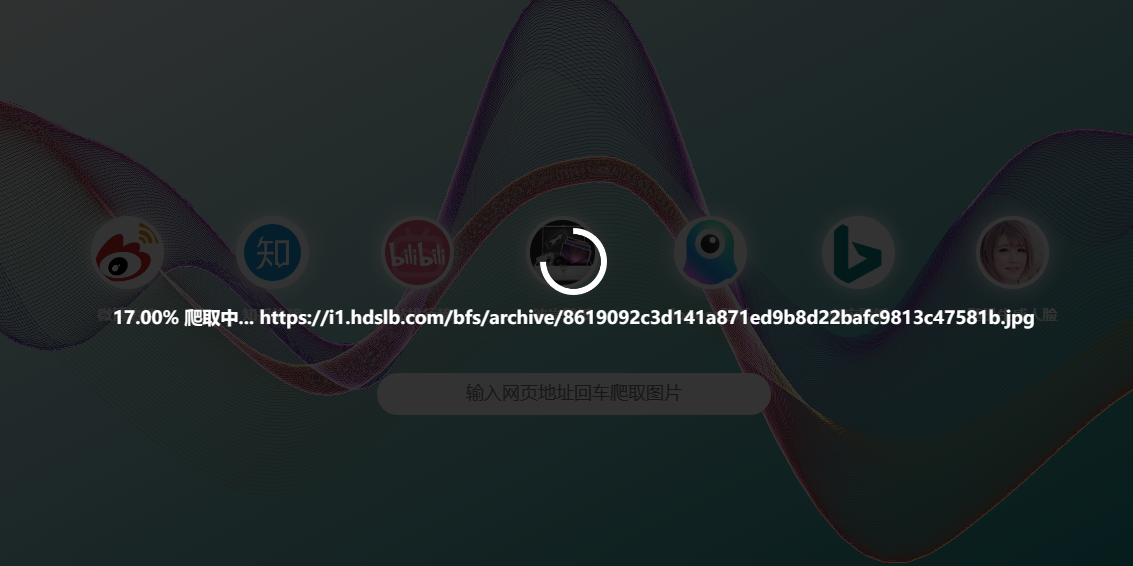
该项目中前后端数据交互接口大多使用的是get请求,但有一个除外,反显爬取进度的接口:/getTaskState。
该接口使用的是SSE,爬取的进度与链接是实时显示的。
最近火热的ChatGPT的流式输出(像人打字一样一个字一个字的显示)使用的便是这个。
SSE虽然与WebSocket一样都是长链接,但不同的是,WebSocket为双工通信(服务器与客户端双向通信),SSE为单工通信(只能服务器向客户端单向通信)。
项目中node服务端发送数据是这样的:
// 事件流获取任务状态app.get('/getTaskState', async (req, res, next) => {res.writeHead(200, {'Content-Type': 'text/event-stream','Cache-Control': 'no-cache','Connection': 'keep-alive',});let sendStr = ''//发送的消息let id = setInterval(() => {msgList = getMsg();//消息列表不为空且最后一条消息不等于上一次发送的消息才能执行if (msgList.length != 0 && msgList[msgList.length - 1] != sendStr) {sendStr = msgList[msgList.length - 1];console.log('\x1B[32m%s\x1B[0m', sendStr)res.write(`data: ${sendStr}\n\n`);//发送消息}}, 10);req.on('close', () => {clearMsg();//清空消息res.end();//结束响应clearInterval(id);//清除定时器(否则内存泄漏)});});
需要在res.writeHead中Content-Type设置为text/event-stream即表示使用SSE发送数据。
res.write(‘data: test\n\n’)即表示发送消息:test,每次发送消息需要以data:开头,\n\n结尾。
使用setInterval控制消息发送频率。
需要在服务端监听何时关闭,使用req.on(‘close’,()=>{})。
监听到关闭时执行响应结束res.end()与清除定时器clearInterval(id)。
在vue客户端接收数据是这样的:
//事件流获取任务状态
const getTaskState = () => {stateMsg.value = "";isState.value = true;let eventSource = new EventSource(origin.value + '/getTaskState');eventSource.onmessage = (event) => {if (event.data != '$END') {stateMsg.value = event.data;} else {eventSource.close();//关闭连接(防止浏览器3秒重连)stateMsg.value = '执行完成!是否打开数据文件夹?';isState.value = false;setTimeout(() => {confirm(stateMsg.value) &&axios.get(origin.value + '/openDir').then(res => { })//打开数据文件夹}, 100);}};//处理错误eventSource.onerror = (err) => {eventSource.close();//关闭连接stateMsg.value = ''isState.value = false;};
};
直接在方法中new一个EventSource(url),这是H5中新提出的对象,可用于接收服务器发送的事件流数据。
使用EventSource接收数据,直接在onmessage中获取event.data即可。
关闭连接记得使用eventSource.close()方法,因为服务器单方面关闭连接会触发浏览器3秒重连。
处理错误使用eventSource.onerror方法。
关于关闭SSE连接的时机,这是由node服务端决定的。
我在后端有一个store专门用于存储消息数据:
store/index.js
let msgList = [];//消息列表function addMsg(msg) {msgList.push(msg);
}function getMsg() {return msgList;
}function clearMsg() {//清空msgList中元素msgList = [];
}module.exports = {addMsg,getMsg,clearMsg
};
- 在爬取数据时,后端会计算爬取的进度,将生成的消息字符串push到msgList列表中,每隔10ms发送给前端msgList列表中的最后一个元素。
- 当后端数据爬取完成时会向msgList中push存入指定字符串:$END,表示获取完成。
- 当前端识别到获取的消息为$END时,关闭连接。
- 后端监听到前端连接被关闭,则后端也关闭连接。
pkg打包
全局安装pkg时最好网络环境为可访问github的环境,否则你只能手动下载那个失败的包再扔到指定路径。
pkg安装完成后需要在package.json中配置一番(主要是配置assets,将public与需要的依赖包打包进exe中)。
这是我的package.json配置:
{"name": "worm","version": "0.1.3","description": "","bin": "./index.js","scripts": {"start": "node-dev ./index.js","dist": "node pkg-build.js"},"pkg": {"icon": "./public/img/icon.ico","assets": ["public/**/*","node_modules/axios/**/*.*","node_modules/cheerio/**/*.*","node_modules/cron/**/*.*","node_modules/express/**/*.*"]},"author": "","license": "ISC","dependencies": {"axios": "^0.27.2","cheerio": "^1.0.0-rc.12","cron": "^2.3.1","express": "^4.18.2","node-dev": "^8.0.0"}
}
我的打包命令是通过scripts中的dist在pkg-build.js中引入的,因为我需要将版本号输出在打包出的exe文件名中。
若打包命令直接写在package.json的scripts中会无法读取打包进程中项目的version。
这是我的pkg-build.js:
//只有通过node xxx.js方式执行的命令才能获取到package.json的version
const pkg = require('./package.json'),{ execSync } = require('child_process');const outputName = `dist/worm_v${pkg.version}.exe`;//拼接文件路径
const pkgCommand = `pkg . --output=${outputName} --target=win --compress=GZip`;//打包命令
execSync(pkgCommand);//执行打包命令上面命令中的output表示输出路径(包含exe文件名),target表示打包的平台,compress表示压缩格式。
需要注意的是使用pkg打包时,项目中axios的版本不能太高。
否则即使你将axios写在pkg的打包配置里也无济于事,我使用的axios版本为0.27.2。
解决跨域
我node使用的是express,直接在header中配置Access-Control-Allow-Origin为* 即可。
app.all('*', (req, res, next) => {res.header("Access-Control-Allow-Origin", "*");//允许所有来源访问(设置跨域)res.header("Access-Control-Allow-Headers", "X-Requested-With,Content-Type");//允许访问的响应头res.header("Access-Control-Allow-Methods", "PUT,POST,GET,DELETE,OPTIONS");//允许访问的方法res.header("X-Powered-By", ' 3.2.1');//响应头res.header("Content-Type", "application/json;charset=utf-8");//响应类型next();});
child_process模块
众所周知,node是单线程运行的,在主线程中执行大量计算任务时会产生无响应的问题。
但node内置的child_process模块却可以创建新的进程,在新进程中执行操作不会影响到主进程的运行。
在此项目中自动打开浏览器、打开指定文件夹、执行打包命令用的就是它。
// 打开数据文件夹
app.get('/openDir', (req, res) => {res.send('ok');//打开文件夹,exe环境下需要使用exe所在目录let filePath = isPkg ?`${path.dirname(process.execPath)}${dir.replace('./', '\\')}` :path.resolve(__dirname, dir);exec(`start ${filePath}`);
});//监听端口
app.listen(port, () => {let url = `http://${ipStr}:${port}`;isPkg && exec(`start ${url}`);//打包环境下自动打开浏览器//判断是否存在exportData文件夹,没有则创建fs.exists(dir, async (exists) => {!exists && fs.mkdir(dir, (err) => { });})console.log('\x1B[31m%s\x1B[0m',`\n
${time} 爬虫服务开启!\n
运行过程中禁止点击此窗口!\n
如需关闭爬虫关闭此窗口即可!\n`);
});
设置静态资源
前端使用vue开发时,需要将vue.config.js中的publicPath配置设置为./之后再打包。
将vue打包后dist内的文件拷贝到node项目的public目录下。
需要在express设置请求头之前使用static(path.join(__dirname, ‘./public’))设置静态资源:
const app = express();
const isPkg = process.pkg;//判断是否为打包环境
const port = isPkg ? 2222 : 1111;//端口
const ipStr = getLocalIp();//获取本机ip
let time = getFormatTime();//获取格式化时间
let dir = './exportData';
app.use(express.json());//解析json格式
app.use(express.static(path.join(__dirname, './public')));//设置静态资源
app.all('*', (req, res, next) => {res.header("Access-Control-Allow-Origin", "*");//允许所有来源访问(设置跨域)res.header("Access-Control-Allow-Headers", "X-Requested-With,Content-Type");//允许访问的响应头res.header("Access-Control-Allow-Methods", "PUT,POST,GET,DELETE,OPTIONS");//允许访问的方法res.header("X-Powered-By", ' 3.2.1');//响应头res.header("Content-Type", "application/json;charset=utf-8");//响应类型next();
});
关于运行时的黑框
双击exe时,不仅会弹出浏览器用户页面,还会弹出黑框,点击黑框内部还会暂停程序运行。
我有想过使用pm2守护进程干掉黑框,但想到关闭爬虫时只需关闭黑框即可,便留下了黑框。

限制爬取次数
做人,特别是做开发,你得有道德,你把人家网站给玩儿崩了这好吗(′⌒`)?
没有任何东西是无限制的,我的限制是放在前端的(可能不太严谨),以爬取壁纸为例,调用inputLimit(num),入参为执行次数,方法是这样的:
//输入限制
const inputLimit = (pageNum) => {let val = prompt(`输入执行次数(小于等于${pageNum})`, "");if (val == null || isNaN(val) || parseInt(val) < 1 || parseInt(val) > pageNum) {return false;}return parseInt(val);
};//彼岸壁纸
const bianWorm = () => {let val = inputLimit(10);if (val) {axios.get(origin.value + '/bianWorm?pageNum=' + val).then(res => { });getTaskState();}
};
后端获取到pageNum参数后,以此作为执行爬虫逻辑的循环依据。
结语
这是我第一次用js玩儿爬虫,很多地方可能不太完善,还请大佬们指出,谢谢啦!
此项目仅供学习研究,勿作他用。
原文链接:https://xiblogs.top/?id=60
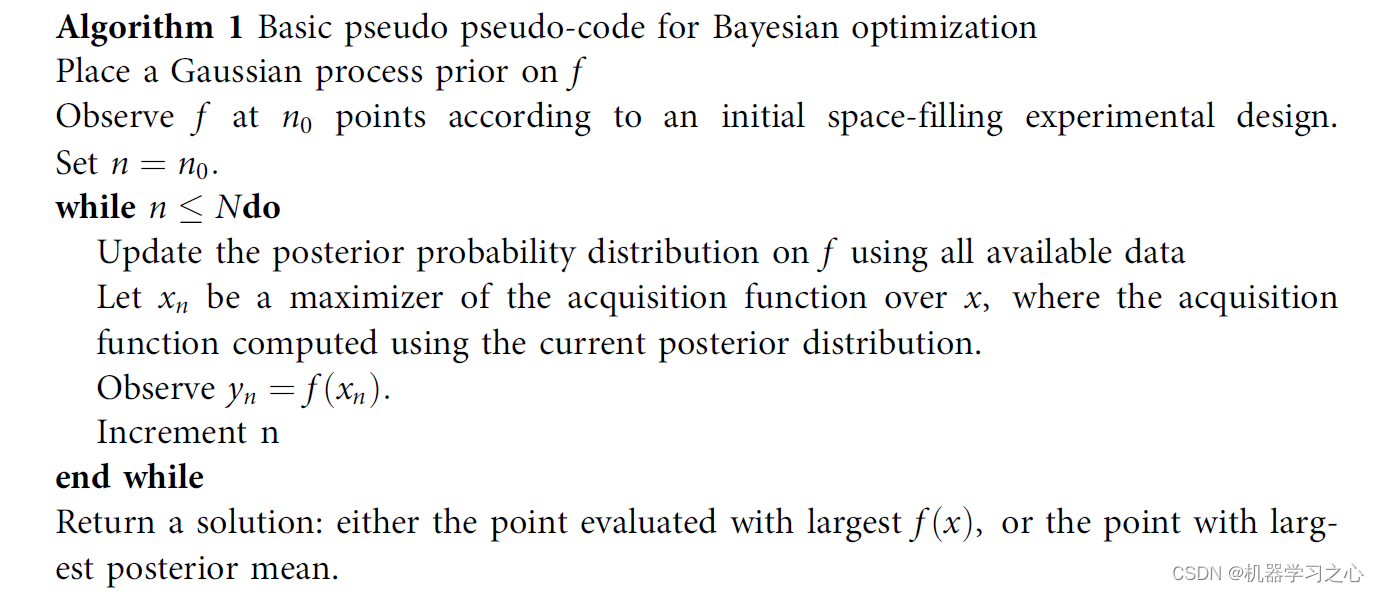


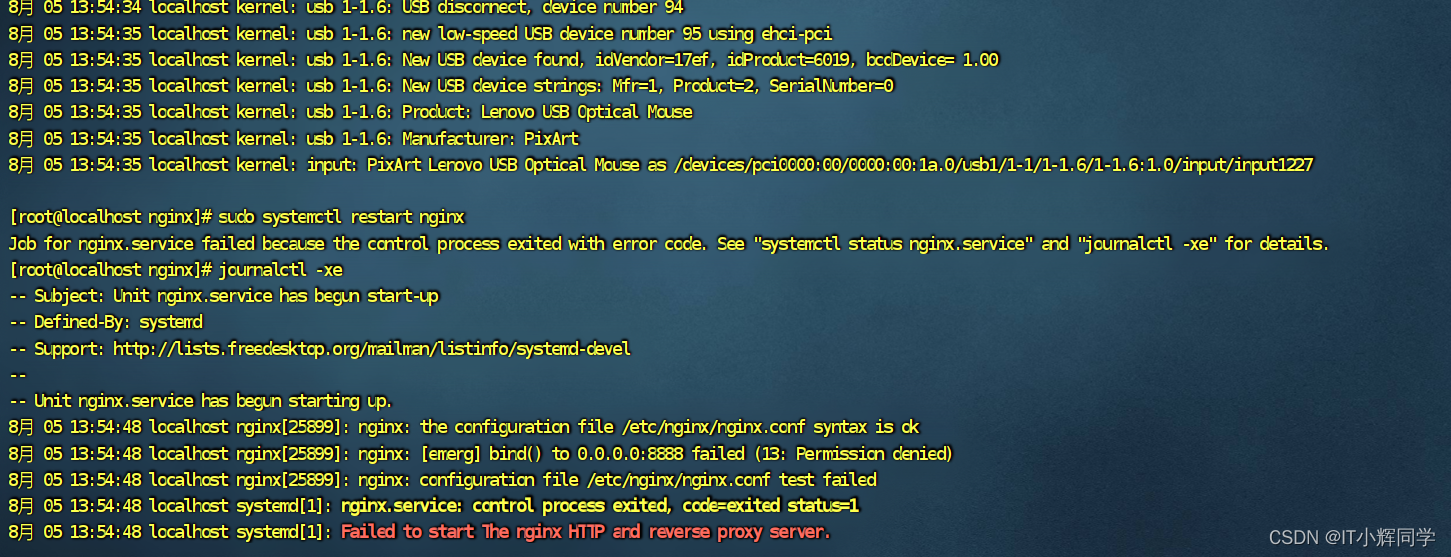
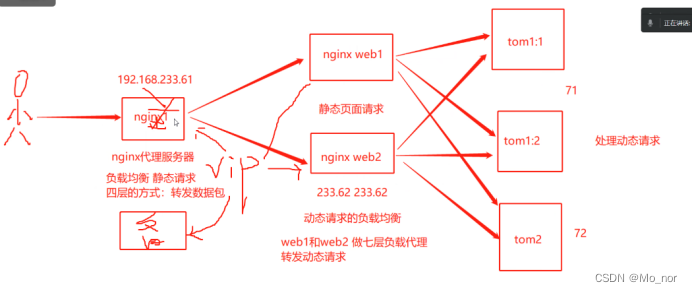
![[免费在线] 将 PDF 转换为 Excel 或 Excel 转换为 PDF | 5 工具](https://img-blog.csdnimg.cn/img_convert/ada8fe280f90ec4d4a4a9f050c4e5f53.png)
